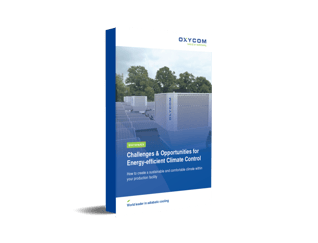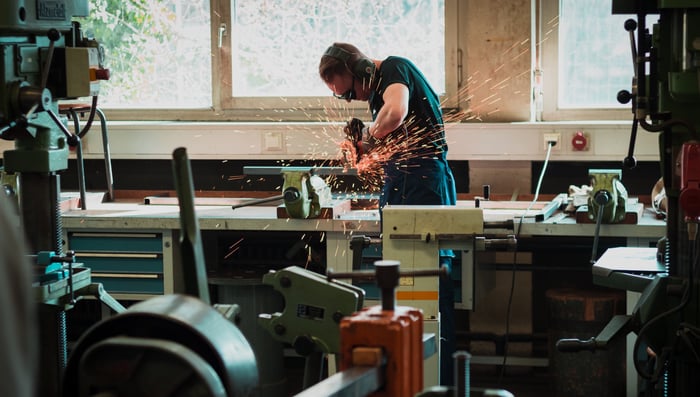The indoor climate of a production facility has a significant influence on the productivity of its employees. This includes the indoor air temperature, the level of ventilation and the indoor air quality. However, production facilities often fall short in terms of adequate climate control. In this blog, we will discuss the effects of ventilation, temperature and humidity on the productivity in the workplace and provide you with tips on how to boost productivity within your production facility.
Ventilation: an absolute necessity
It is often underestimated how important ventilation is to our comfort and well-being. Spaces should always be ventilated using fresh outside air, not only in our homes, offices and schools but in workplaces as well. Production facilities are often enormous spaces with high ceilings. These large spaces are difficult to cool with traditional air-conditioning due to the need to recirculate all the air in the building to control the energy costs. Adding ventilation would increase the already substantial energy costs and therefor cooling and ventilation are often both lacking. Besides, if there is a traditional climate control system in place, this only recirculates the air and does not provide fresh air (O2). The above results in (unhealthy) increased levels of CO2 in the workplace. Higher concentrations of CO2 impair the concentration of your employees heavily, which in turn decreases their productivity.
Furthermore, industrial processes may release a lot of (toxic) gases, vapours and dust. These conditions have a severe effect on the comfort (and let’s not forget health) of your employees and will result in a decrease in productivity.
Therefore, to boost productivity, it is critical to have an adequate ventilation system in place in your production facility, that uses fresh and filtered outside air. Besides, sufficient provision of fresh air can reduce the number of sick leave reports up to 35%.
An example:
- On average, Dutch people spend 90% of the day indoors;
- Already in the 80's the WHO estimated that about 30% of the buildings had a bad indoor climate;
- The costs of a bad indoor climate amount to about €3,600 per employee per year.
For traditional cooling installations, additional ventilation usually cost a lot of energy. However, the increased yield is, in many cases, far greater compared to the additional investment in the installation and the increase in energy costs.
Curious how you can create a comfortable and productive working climate while minimizing your energy consumption? Read “Challenges and Opportunities for Energy-Efficient Climate Control”
Dehumidification: a great discomfort
Traditional climate control systems dehumidify the air. While this may be beneficial during the most humid period of the year when humidity levels rise above 60% (in Europe, for instance the middle of Germany this equals only about to 100 hours p. year), for the rest of the year dehumidifying the air can cause a lot of discomfort for your employees. When the air is too dry, this can irritate the eyes and the throat. As a result of this discomfort, employees are less concentrated and become less productive in their work. That is why it is crucial for production facilities to have a climate control system in place that provides the air with enough humidity for employees to feel comfortable as well as to protect them from the unlimited spread of virussen through the air.
For more information on the added benefits of sufficient indoor humidification, please read our blog
High temperatures equal reduced productivity
Research shows that when indoor temperatures are 22 ℃ or warmer, productivity drops by about 2% per degree. This is a challenging fact for most production facilities. Not only do the outside temperatures and hours of sunlight affect the indoor climate, the heat that is generated by the production machinery also increases the indoor temperature. As a result, indoor temperatures can quickly rise to 10 ℃ above the outside temperature. With an outside temperature of 22 ℃, this means that productivity decreases by at least 20 %. Therefore it is essential for production facilities to have an effective cooling and ventilation system in place to minimize the decline in productivity due to the indoor temperature.
Boost productivity up to 15% with a comfortable indoor climate
The indoor climate of a production facility has a significant influence on the comfort and thus productivity of its employees. A pleasant indoor climate rockets productivity by 10-15% and increases output. The increased yield is, in many cases, large compared to the additional investment of an effective cooling and ventilation system.
We recognize that production facilities face the challenge of creating an indoor climate that is beneficial to their employees. This is especially challenging as traditional climate control systems cost a lot of energy to create such a climate, while production facilities need to reduce their energy consumption.
 In our whitepaper “Challenges and Opportunities for Energy-Efficient Climate Control”, we describe how you can create a comfortable and sustainable indoor climate within your production facility.
In our whitepaper “Challenges and Opportunities for Energy-Efficient Climate Control”, we describe how you can create a comfortable and sustainable indoor climate within your production facility.





